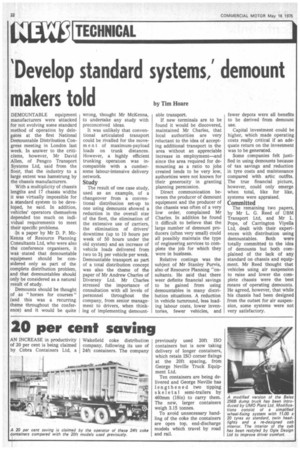'Develop standard systems,' demount
Page 24

If you've noticed an error in this article please click here to report it so we can fix it.
makers told by Tim Hoare DEMOUNTABLE equipment manufacturers were attacked for not evolving some standard method of operation by delegates at the first National Demounta.ble Distribution Congress meeting in London last week. In answer to the criticisms, however, Mr David Allen, of Pengco Transport Systems Ltd, said from the floor, that the industry to a large extent was hamstrung by the chassis manufacturers.
With a multiplicity of chassis lengths and 17 chassis widths it was virtually impossible for a standard system to be developed, he said. In addition, vehicles' operators themselves depended too much on individual requirements to meet their specific problems.
In a paper by Mr D. P. McKenna of Resource Planning Consultants Ltd, who were also the conference organisers, it was stated that demountable equipment should be considered only as part of the complete distribution problem, and that demountables should only be considered as a natural result of study.
Demounts should be thought of as "horses for courses" (and this was a recurring theme throughout the conference) and it would be quite wrong, thought Mr McKenna, to undertake any study with preconceived ideas.
It was unlikely that conventional articulated transport could be rivalled for the movement of maximum-payload loads on trunk distances. However, a highly efficient trunking operation was incompatible with a cumbersome labour-intensive delivery network.
Study
The result of one case study, used as an example, of a changeover from •a conventional distribution set-up to one using demounts showed a reduction in the overall size of the fleet, the elimination of the extensive use of carriers, the elimination of drivers' downtime (up to 10 hours per week of 50 hours under the old system) and an increase of vehicle loads delivered from two to 3+ per vehicle per week. Demountable transport as part of a total distribution concept was also the theme of the paper of Mr Andrew Charles of Diversey Ltd. Mr Charles stressed the importance of consultation with all levels of personnel throughout the company, from senior management to drivers, when thinking of implementing demount able transport.
If new terminals are to be found it would be discovered, maintained Mr Charles, that local authorities are very reluctant to the idea of accepting additional transport in the area without an appreciable increase in employment—and since the area required for demounting as a ratio to jobs created tends to be very low, authorities were not known for their generosity in granting planning permission.
Direct communication between the producer of demount equipment and the producer of the chassis was often of a very low order, complained Mr Charles, In addition he found it difficult to believe that the large number of demount producers (often very small) could all possibly maintain the type of engineering services to complete the job for which they were in business.
Relative castings was the subject of Mr Stanley Purvis, also of Resource Planning '"onsultants. He said that there weer definite financial savings to be gained from using demountables in many distribution situations. A reduction in vehidle tumround, less loading labour costs, lower inventories, fewer vehicles, and fewer depots were all benefits to be derived from demount use.
Capital investment could be higher, which made operating costs really critical if an adequate return on the investment was to be generated.
Some companies felt justified in using .demounts because of tax savings and reduction in tyre costs and maintenance compared with attic outfits. The true financial picture, however, could only emerge when total, like for like, systems were appraised,
Committed
The remain mg two papers, by Mr L. G. Reed of UBM Transport Ltd, and Mr L. Pope, of Carrington Viyella Ltd, dealt with their experiences with distribution using demountables. Both were totally committed to the idea of demounts but both complained of the lack of any standard on chassis and equipment. Mr Reed thought that vehicles using air suspension to raise and lower the complete chassis were the best means of operating demounts. He agreed, however, that while his chassis had been designed from the outset for air suspension, some systems were not very satisfactory.




























































































